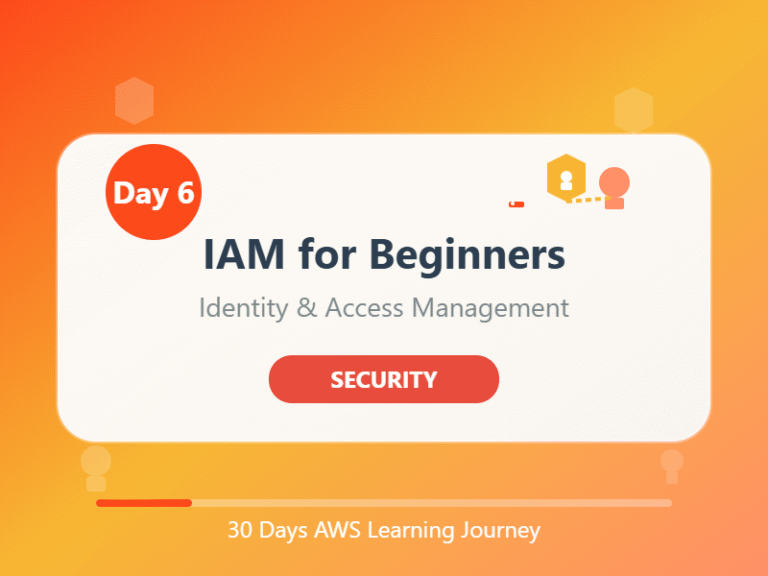Day 6: IAM Basics — Control Who Can Do What in AWS
Goal: Understand how IAM helps manage users, passwords, and permissions in AWS.
👥 What is IAM?
IAM stands for Identity and Access Management.
It helps you securely control who can access your AWS resources — like S3 buckets, EC2 instances, and more.
🧠 Think of IAM as:
“A security gatekeeper that decides who can enter, and what they’re allowed to do.”
✅ Why is IAM Important?
- Keeps your account safe from misuse
- Lets you create different users for your team
- Allows you to limit access (e.g., one user can only view S3, another can launch EC2)
📖 IAM Basic Concepts (Made Simple)
| Term | What It Means |
|---|---|
| User | A person or application that logs in |
| Group | A collection of users with shared permissions |
| Role | A temporary identity for apps/services |
| Policy | A set of rules that define what is allowed or denied |
| Permissions | What a user can or can’t do in AWS |
| Root User | The main admin — never use it for daily tasks! |
🛠️ Step-by-Step: Create an IAM User
- Go to AWS Console → Search for IAM → Open it
- In the left menu, click “Users” → Click “Add users”
- Choose:
- Username: (e.g.,
developer1) - Check ✅ “Access key – Programmatic access” (optional)
- Check ✅ “Password – AWS Management Console access”
- Username: (e.g.,
- Set a password (temporary is fine)
- On the Permissions screen:
- Choose “Attach existing policies directly”
- Search for
AdministratorAccess(just for demo) and select it
- Click “Next” → “Create user”
🎉 You now have a new AWS user!
🔑 Sign in as the New User
- IAM will give you a login link like:
https://1234567890.signin.aws.amazon.com/console - Open it and log in using the new user’s credentials
Now you’re using AWS without the root account — much safer!
🔏 Policies (Very Simply)
A policy is a document that says:
“This user/group/role can or cannot do these things.”
Example:
- Allow user to read S3
- Deny user from deleting EC2
Policies are written in JSON (don’t worry — we’ll simplify that later).
🧪 Mini Challenge
✅ Create a second IAM user with S3 read-only access:
Use the AmazonS3ReadOnlyAccess policy.
✅ Try logging in and see if they can access S3 but not EC2.
📝 Quick Recap
- IAM controls who can do what in AWS
- You created users with safe access
- You learned about users, groups, roles, policies
- You stopped using the root account for daily work (good job!)
🔁 Navigate the Series:
⬅️ Day 5: EC2 Basics — Launch Your First Cloud Server
➡️Day 7: Amazon EBS & EFS – Learn AWS Storage Basics

